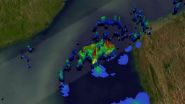(Press-News.org) On April 2, 2014, the sun emitted a mid-level solar flare, peaking at 10:05 a.m. EDT, and NASA's Solar Dynamics Observatory captured imagery of the event. Solar flares are powerful bursts of radiation. Harmful radiation from a flare cannot pass through Earth's atmosphere to physically affect humans on the ground, however -- when intense enough -- they can disturb the atmosphere in the layer where GPS and communications signals travel.
To see how this event may impact Earth, please visit NOAA's Space Weather Prediction Center at http://spaceweather.gov, the U.S. government's official source for space weather forecasts, alerts, watches and warnings.
This flare is classified as an M6.5 flare. M-class flares are ten times less powerful than the most intense flares, which are labeled X-class. The number after the M provides more information about its strength. An M2 is twice as intense as an M1, an M3 is three times as intense, etc.
INFORMATION:
Frequently Asked Questions Regarding Space Weather
NASA releases images of M-class solar flare
2014-04-02
ELSE PRESS RELEASES FROM THIS DATE:
NASA sees Tropical Cyclone's Hellen's lively remnants
2014-04-02
Powerful Tropical Cyclone Hellen rapidly weakened after hitting northwestern Madagascar but Hellen's remnants have recently started to show signs of life. The TRMM satellite flew over these remnants in the Mozambique Channel on April 2, 2014 at 0143 UTC.
A rainfall analysis using the Tropical Rainfall Measuring Mission's (TRMM) Microwave Imager (TMI) and Precipitation Radar (PR) instruments found that some strong convective thunderstorms had developed in the area. It was revealed by TRMM PR data that rain was falling at a rate of over 75 mm/~ 3 inches in a few locations.
TRMM's ...
River ice reveals new twist on Arctic melt
2014-04-02
A new study led by Lance Lesack, a Simon Fraser University geographer and Faculty of Environment professor, has discovered unexpected climate-driven changes in the mighty Mackenzie River's ice breakup. This discovery may help resolve the complex puzzle underlying why Arctic ice is disappearing more rapidly than expected.
Lesack is the lead author on Local spring warming drives earlier river-ice breakup in a large Arctic delta. Published recently in Geophysical Research Letters, the study has co-authors at Wilfrid Laurier University, the University of Alberta and Memorial ...
Body odor changes following vaccination
2014-04-02
PHILADELPHIA (April 2, 2014) – Our understanding of the role of body odor in conveying personal information continues to grow. New research from the Monell Chemical Senses Center and the U.S. Department of Agriculture (USDA) reveals that immunization can trigger a distinct change in body odor. This is the first demonstration of a bodily odor change due to immune activation.
The findings will appear in the April 10 issue of Physiology and Behavior. In addition, portions of the work will be presented on April 10 at the 36th Annual Meeting of the Association for Chemoreception ...
Science-themed music videos boost scientific literacy, study shows
2014-04-02
As the United States puts ever-greater emphasis on science, technology, engineering and mathematics education to keep competitive in the global economy, schools are trying to figure out how to improve student learning in science.
University of Washington researchers Katie Davis and Greg Crowther think music may be the answer for some kids. They studied the ability of music videos to enhance students' understanding of scientific concepts.
Davis will present "Sing about Science: Leveraging the Power of Music to Improve Science Education" on Friday (April 4) at the American ...
Gauging the impact of tropical forest logging: Winrock develops new method for quantifying carbon emissions
2014-04-02
ARLINGTON, Va. (April 2, 2014) — Researchers at Winrock International have developed a first-of-its-kind method for estimating carbon emissions from forest degradation caused by selective logging in tropical regions. Refined over a period of 15 years and tested in six countries, the approach is highlighted in an article authored by Winrock's Ecosystems Services experts, Timothy Pearson, Sandra Brown and Felipe Casarim — published April 1 in Environmental Research Letters.
Until now, efforts for reducing emissions from deforestation and forest degradation (REDD+) in developing ...
NIST's simple microfluidic devices now have valves
2014-04-02
Researchers at the National Institute of Standards and Technology (NIST) have added yet another innovation—miniature valves—to their ever-growing collection of inexpensive, easy-to-manufacture and highly efficient microfluidic devices made from plastic films and double-sided tape.
Traditionally, microfluidic devices—tiny gadgets with fluid-carrying channels used in medical diagnostics, DNA forensics and "lab-on-a-chip" chemical analyzers—have been fabricated like microchips using photolithography. A desired pattern of micrometer-sized channels and ports is created on ...
To boldly go? Experts issue ethics guidelines for NASA's next generation of risky missions
2014-04-02
Nearly two years after the conclusion of its space shuttle program left Americans wondering what would become of the spacefaring dreams of decades past, NASA has sought the advice of health and ethics experts for protecting astronauts on its "next generation" of long duration and exploration-class human spaceflights.
Such missions, including extended stays on the International Space Station and flights to Mars, have higher risks and are unlikely to meet the space agency's current health standards. Options not on the table, according to the Institute of Medicine (IOM) ...
Notre Dame researchers provide new insights into quantum dynamics and quantum chaos
2014-04-02
A team of researchers led by University of Notre Dame physicist Boldizsar Janko has announced analytical prediction and numerical verification of novel quantum rotor states in nanostructured superconductors.
The international collaborative team points out that the classical rotor, a macroscopic particle of mass confined to a ring, is one of the most studied systems in classical mechanics. In a paper appearing in the April 1 issue of the journal Nature Scientific Reports, Janko and colleagues Shi-Hsin Lin, Milorad Milosevic, Lucian Covaci and Francois Peeters of the Universiteit ...
Gastro outbreaks hit elderly hardest
2014-04-02
Frail elderly people living in residential care facilities are at increased risk of severe illness or death from outbreaks of viral gastroenteritis.
This is the finding from a study led by Craig Davis from Department of Health Queensland, published in the April issue of the Australian and New Zealand Journal of Public Health.
"Importantly, prompt notification of outbreaks to public health units led to a much shorter duration of the outbreak," Mr Davis said.
"Notification of outbreaks to public health units should occur within 24 hours of any outbreak so that diagnostic ...
Ancient volcanic explosions shed light on Mercury's origins
2014-04-02
PROVIDENCE, R.I. [Brown University] — The surface of Mercury crackled with volcanic explosions for extended periods of the planet's history, according to a new analysis led by researchers at Brown University. The findings are surprising considering Mercury wasn't supposed to have explosive volcanism in the first place, and they could have implications for understanding how Mercury formed.
On Earth, volcanic explosions like the one that tore the lid off Mount St. Helens happen because our planet's interior is rich in volatiles — water, carbon dioxide and other compounds ...




